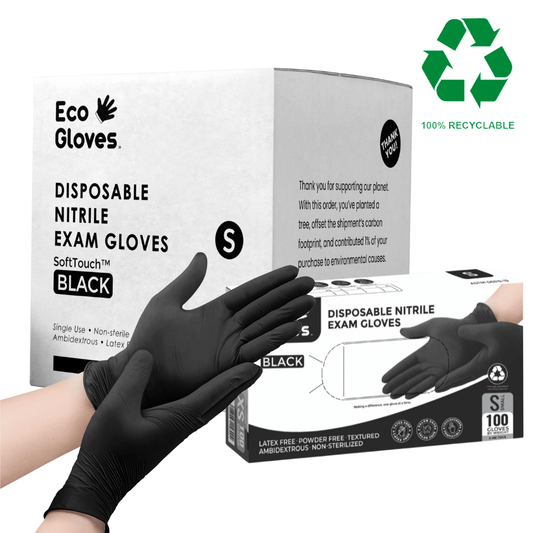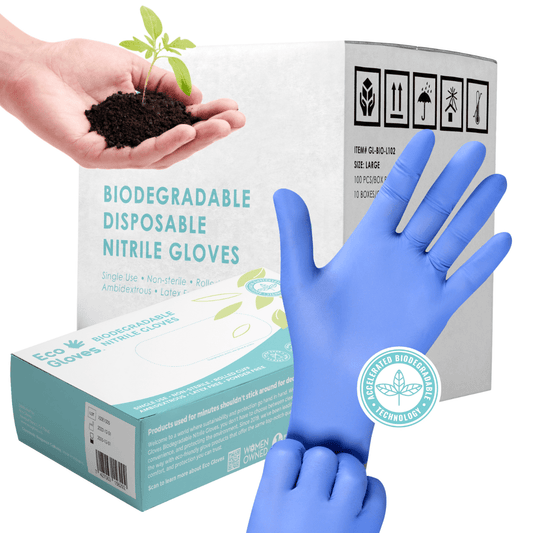The Ultimate Buyer's Guide to Eco-Friendly Gloves: Selecting the Best Sustainable Disposable Gloves in 2024
Eco GlovesDisposable gloves are a staple in numerous industries, from healthcare to cleaning to food preparation. However, the environmental impact of billions of gloves entering landfills and oceans each year cannot be ignored. As consumer awareness grows, the demand for eco-friendly solutions is reshaping the way businesses operate. This guide will explore why eco-friendly disposable gloves are a smart choice for sustainability and how to select the best options for your needs.
Topics Covered
- Environmental Impact of Single-Use Gloves: From Landfills to Oceans
- Green Manufacturing: Why Industries Are Adopting Eco-Friendly Disposable Gloves
- Top 5 Sustainable Alternatives to Conventional Disposable Gloves
- Essential Features of High-Performance Biodegradable Disposable Gloves
- 7 Common Pitfalls to Avoid When Choosing Eco-Friendly Disposable Gloves
- Cost-Effective Benefits of Switching to Compostable Gloves for Your Business
- Frequently Asked Questions About Sustainable Gloves
Environmental Impact of Single-Use Gloves: From Landfills to Oceans
Disposable gloves play a crucial role in maintaining hygiene and safety across various industries, from healthcare to food service. However, the widespread use of traditional materials such as vinyl, polyethylene, and nitrile in these gloves presents significant environmental challenges. These synthetic materials can take hundreds of years to decompose, leading to a cascade of ecological issues, including:
Microplastic Pollution and Landfill Overcrowding from Disposable Waste
Gloves contribute to rapidly filling landfills around the world. Polyethylene and vinyl gloves are particularly resistant to breaking down, contributing to mounting landfill waste. These materials linger in the environment, releasing harmful chemicals during the breakdown process.
Ocean Pollution from Disposable Gloves
Improper disposal of trash, plastic, gloves and other debris typically leads to pollution of waterways. This waste often ends up in oceans, harming marine life. Gloves discarded improperly can fragment into microplastics, which disrupt ecosystems and enter the food chain.

Marine Life Harm Due to Glove Pollution
Marine animals, such as sea turtles, may mistake floating gloves for food, leading to injuries or fatalities. The World Wildlife Fund (WWF) reports that thousands of marine species are affected by plastic waste every year, disrupting habitats and breeding grounds.
Soil Contamination from Decomposing Gloves
Decomposing synthetic materials, including gloves, often leach chemicals and toxins into landfills and waterways when they leave for prolonged periods. This has an impact on soil fertility, groundwater quality, and microbial communities, further affecting our food source and health.
Air Pollution from Glove Incineration
When gloves are not thrown in landfills, composted, or recycled, the other option is incineration, particularly for gloves and other products that have been contaminated. Incineration of gloves releases toxic fumes and greenhouse gases into the air, which contribute to overall air quality degradation and potential health risks from airborne particles.
Resource Depletion
The production of synthetic gloves relies heavily on non-renewable petroleum resources. These energy-intensive manufacturing processes often contribute to high carbon footprint through production and transportation.
Understanding these far-reaching impacts underscores the urgent need for sustainable alternatives and responsible disposal practices in the disposable glove industry. As we continue to rely on these essential items for safety and hygiene, finding eco-friendly solutions becomes not just an environmental imperative but a global health and economic necessity.
Green Manufacturing: Why Industries Are Adopting Eco-Friendly Disposable Gloves
Businesses across various sectors are recognizing the need for sustainable initiatives. Eco-friendly disposable gloves are one way to reduce environmental impact while maintaining safety and hygiene. Companies adopting these solutions often experience:
- Regulatory Compliance: Many governments are implementing stricter rules regarding plastic waste, making eco-friendly products essential.
- Enhanced Customer Trust: Consumers increasingly support brands demonstrating environmental responsibility.
-
Operational Sustainability: Durable and sustainable gloves can reduce waste and align with broader sustainability goals.
Top 5 Sustainable Alternatives to Conventional Disposable Gloves
Eco-friendly disposable gloves are now widely available, offering practical solutions to reduce waste without compromising on performance or safety. Here are some key sustainable alternatives:
1. Biodegradable Nitrile Gloves
These gloves are made from nitrile with accelerated degradation technology, breaking down faster in landfills compared to traditional gloves.
- Decompose within 1 to 5 years in active landfills, compared to 200+ years for conventional nitrile gloves
- Use additives that act as a "food source" to attract microorganisms in landfills
- Microbes break down the gloves into organic soil, methane, and carbon dioxide
- Maintain the same performance standards as traditional nitrile gloves

2. Plant-Based Gloves
Crafted from renewable plant-based materials, these gloves offer a sustainable alternative to petroleum-based products.
- Made from materials like cornstarch (Polylactic Acid or PLA)
- Compostable and made from annually renewable resources
- Reduce dependency on fossil fuels
- Best suited for light-duty tasks, particularly in food service industries
- May have a higher price point compared to conventional options
3. Compostable Gloves
These gloves are designed to break down completely in industrial composting facilities.
- Often made from plant-based materials or accelerated biodegradable polymers
- Return nutrients to the soil after decomposition
- May require specific disposal in industrial composting facilities for proper breakdown
- May not be suitable for all applications due to potential differences in durability, or material

4. Natural Latex Gloves
Made from rubber tree sap, these gloves offer a renewable and biodegradable option.
- Decompose much faster than synthetic gloves under appropriate conditions
- Renewable resource that can be harvested sustainably
- Potential for allergic reactions in some individuals
- May not be suitable for all applications due to latex allergies
5. Recyclable Gloves
Some manufacturers offer recycling programs to repurpose used gloves, supporting a circular economy.
- Programs like TerraCycle's Zero Waste Box allow for recycling of vinyl, nitrile, and latex gloves
- The RightCycle Program by Kimberly-Clark Professional transforms eligible PPE into new consumer goods
- Recycled gloves can be processed into plastic pellets for new products
- Reduces landfill waste and supports company sustainability goals

6. Emerging Glove Technology
- rPET (Recycled Polyethylene Terephthalate) like gloves made from repurposed plastics
- Hybrid gloves combining multiple sustainable materials for optimal performance and eco-friendliness
- Essential Features of High-Performance Biodegradable Gloves
When selecting sustainable gloves, consider factors such as intended use, disposal methods available, and specific environmental certifications. Look for third-party verifications and be aware of potential greenwashing. Remember that even if a glove doesn't have all eco-friendly features, choosing options with reduced environmental impact can still make a significant difference in sustainability efforts.
Essential Features of High-Performance Biodegradable Disposable Gloves
When selecting disposable gloves that are supposed to be better for environment, use this guide to identify the most essential features your eco-friendly gloves should offer:

Fast Biodegradable Rate
Faster decomposition rates minimize environmental impact.
Pro Tip: Look for gloves certified to break down within 1-5 years in industrial composting facilities.
Eco-Friendly Material Composition
Plant-based materials like cornstarch or bamboo are renewable and a key component to making a product more sustainable.
Pro Tip: When possible, choose gloves made from at least 60% bio-based materials for optimal sustainability.
Durable and Tear Resistant
Reinforced areas enhance longevity and reduce glove waste from premature tearing.
Pro Tip: Not all gloves are created equal. Test gloves for puncture resistance to ensure they meet your specific use requirements, or ensure gloves meet stringent puncture and pinhole rate requirements.
Allergen-Free Properties
Hypoallergenic materials reduce risk of skin irritation and allergic reactions.
Pro Tip: Opt for gloves free from common allergens like latex, powder, and chemical accelerators.
Barrier Protection
Effective barriers against liquids, chemicals, or pathogens are crucial for safety.
Pro Tip: Check for relevant certifications (e.g., ASTM D6319 for medical examination gloves) to ensure proper protection.
Comfort and Flexibility
Ergonomic design and stretchable materials improve user comfort during extended wear.
Pro Tip: Choose gloves with elasticity ratings above 500% for optimal flexibility and reduced hand fatigue.
Eco-Friendly Packaging
Recyclable or compostable packaging further reduces environmental footprint.
Pro Tip: Select brands that use minimal, plastic-free packaging made from recycled materials. Also check if packaging with eco-friendly ink (water-based or plant-based ink) to reduce toxic contamination to the environment.
Certifications and Standards
Third-party certifications validate environmental claims and performance standards.
Pro Tip: Look for certifications like ASTM D6400 for compostability or ASTM 5511 and ASTM D5526 for biodegradability.
Bulk Options
Buying eco-friendly gloves in bulk reduces packaging waste and shipping emissions.
Pro Tip: Calculate your monthly glove usage and opt for bulk purchases to maximize sustainability and cost-efficiency.
It's important to note that not all eco-friendly gloves will possess every desirable feature. Don't be discouraged if your selection lacks certain attributes. Even if a glove isn't made from plant-based materials or doesn't offer rapid biodegradability, it can still be environmentally friendly. Look for gloves that utilize fewer non-renewable resources, are manufactured in eco-conscious facilities, or are sourced from environmentally-minded companies like Eco Gloves. These factors contribute significantly to reducing their overall environmental impact.
7 Common Pitfalls to Avoid When Choosing Eco-Friendly Disposable Gloves
As the demand for sustainable products grows, many businesses are turning to eco-friendly disposable gloves. However, navigating this market can be challenging, with potential pitfalls that could undermine your sustainability efforts. This guide highlights seven common mistakes to avoid, ensuring you make an informed decision that aligns with both your operational needs and environmental goals:
 DON'T Assume All "Biodegradable" Claims Are Equal
DON'T Assume All "Biodegradable" Claims Are Equal Not all biodegradable gloves decompose at the same rate or under the same conditions.

 DON'T Overlook Performance for Sustainability
DON'T Overlook Performance for Sustainability
Eco-friendly doesn't always mean high-performance.
 DON'T Ignore End-of-Life Disposal Requirements
DON'T Ignore End-of-Life Disposal Requirements Some biodegradable gloves require specific disposal methods to decompose properly.
 DON'T Fall for Greenwashing
DON'T Fall for Greenwashing
Marketing claims can be misleading or exaggerated.
 DON'T Compromise on Safety Standards
DON'T Compromise on Safety StandardsEco-friendly gloves must still meet relevant safety regulations for your industry.
 DON'T Neglect Employee Training
DON'T Neglect Employee TrainingEven the most sustainable gloves can be wasteful if used improperly.
 DON'T Forget to Consider the Full Lifecycle Impact
DON'T Forget to Consider the Full Lifecycle ImpactThe environmental impact of gloves extends beyond their use and disposal.
By avoiding these common pitfalls, you can make a more informed decision when selecting eco-friendly disposable gloves, ensuring that your choice truly benefits both your operations and the environment.
Cost-Effective Benefits of Switching to Compostable Gloves for Your Business
Adopting sustainable disposable gloves offers significant advantages that extend beyond environmental benefits. Here's a comprehensive look at how this switch can positively impact your business:
- Regulatory Readiness
- Stay ahead of evolving environmental regulations
- Avoid potential fines and penalties associated with non-compliance
- Simplify reporting and documentation for environmental audits
- Customer Appeal
- Attract eco-conscious consumers and clients
- Differentiate your brand in a competitive market
- Align with the values of younger demographics (Millennials and Gen Z)
- Enhance marketing opportunities with sustainable product offerings
- Reduced Waste Management Costs
- Lower disposal fees for non-biodegradable waste
- Potential for reduced waste collection frequency
- Minimize long-term environmental impact and associated costs
- Enhanced Corporate Reputation
- Position your business as a sustainability leader
- Improve relationships with environmentally-focused stakeholders
- Boost employee morale and attract talent who value corporate responsibility
- Supply Chain Optimization
- Potential for lighter packaging and reduced shipping costs
- Opportunity to partner with other eco-friendly suppliers
- Improved inventory management due to longer shelf life of some compostable products
- Tax Incentives and Grants
- Qualify for government incentives promoting sustainable business practices
- Access to grants and funding for green initiatives
- Risk Mitigation
- Reduce exposure to future resource scarcity and price volatility of petroleum-based products
- Minimize potential for negative publicity related to environmental practices
- Innovation Driver
- Encourage research and development in sustainable materials
- Foster a culture of innovation within your organization
- Health and Safety Benefits
- Many compostable gloves are free from harmful chemicals, improving worker safety
- Potential reduction in allergic reactions compared to traditional latex gloves
- Long-term Cost Savings
- While initial costs may be higher, long-term savings can be realized through improved efficiency and reduced environmental impact
- Potential for bulk purchasing discounts as demand for sustainable products increases
Ready to revolutionize your approach to hand protection?
Contact our sustainability experts today to discover how Eco Gloves can help your organization:
- Reduce waste
- Lower carbon footprint
- Enhance your brand's environmental credentials
- Maintain top-tier hand protection standards
- Save on environmentally friendly disposable gloves wholesale purchases
Don't just imagine a more sustainable world—help create it. Reach out to us today and to find the best eco-friendly disposable gloves for cleaning, healthcare, restaurants, salons, medspas, dentistry and more! Together, we can turn everyday choices into extraordinary environmental solutions.
Key Takeaways: The Ultimate Buyer’s Guide to Eco-Friendly Gloves
-
Traditional gloves have a heavy environmental cost: Vinyl, polyethylene, and conventional nitrile gloves can take centuries to break down, causing landfill buildup, ocean pollution, and microplastic contamination.
-
Eco-friendly gloves offer real alternatives: Biodegradable nitrile, compostable, plant-based, natural latex, and recyclable gloves reduce waste and environmental harm.
-
Key features matter: Look for fast biodegradability, durable materials, allergen-free options, strong barrier protection, eco-friendly packaging, and credible certifications.
-
Avoid common pitfalls: Verify environmental claims, align disposal methods with your local facilities, and never compromise on safety standards.
-
Switching to sustainable gloves benefits your business: From regulatory compliance and customer appeal to waste reduction and potential cost savings, eco-friendly gloves support both the planet and your bottom line.
- Eco Gloves is your trusted sustainability partner: Offering high-performance biodegradable and compostable gloves that meet strict quality standards without sacrificing eco goals.
👉 Choosing eco-friendly gloves isn’t just good for the environment—it’s a smart business decision that strengthens your brand, improves safety, and supports long-term sustainability.
Frequently Asked Questions About Sustainable Gloves
-
How long do disposable gloves take to decompose?
Conventional vinyl and nitrile gloves can take hundreds of years to break down. Compostable gloves may decompose within a year in industrial composting facilities, while biodegradable nitrile gloves typically break down in 3–5 years in active landfills. Natural latex gloves often decompose within about 5 years.
-
Are eco-friendly gloves durable?
Yes. Many biodegradable nitrile and high-quality compostable options meet or exceed the durability and performance of traditional gloves.
-
Can eco-friendly gloves be used for heavy-duty tasks?
Yes, depending on the material. Biodegradable nitrile gloves are especially well-suited for demanding applications like cleaning, healthcare, and handling greasy or oily items.
-
Do eco-friendly gloves cost more?
Some options may have a slightly higher upfront price, but they can offer long-term value through durability, reduced waste disposal costs, and improved brand perception.
-
How should I dispose of eco-friendly gloves?
Compostable gloves should be sent to an industrial composting facility. Biodegradable gloves can be disposed of in active landfills. Some brands also offer specialized recycling programs.




















